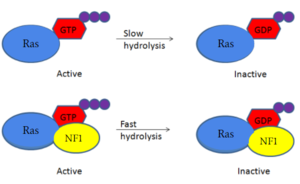Sandbox Reserved 1706
From Proteopedia
(Difference between revisions)
| Line 14: | Line 14: | ||
==Structure== | ==Structure== | ||
| - | Neurofibromin is a [https://en.wikipedia.org/wiki/Protein_dimer protein dimer] that exists in <scene name='90/904311/Closed_conformation/8'>closed</scene> and <scene name='90/904311/Open_conformation/14'> open</scene> conformations. The exact initiation of structural rearrangement is currently unknown and a point of further research. | + | Neurofibromin is a [https://en.wikipedia.org/wiki/Protein_dimer protein dimer] that exists in <scene name='90/904311/Closed_conformation/8'>closed</scene> and <scene name='90/904311/Open_conformation/14'> open</scene> conformations. The exact initiation of structural rearrangement is currently unknown and a point of further research. <ref name="Bourne"> DOI:10.1038/39470</ref><ref name="Lupton"> <ref name="Naschberger"> DOI:10.1038/s41586-021-04024-x</ref>. Both protomers contain 5 separate domains, a N-HEAT ARM, C-HEAT ARM, GRD active site, GAPex subdomain, and Sec14-PH domain. |
===Domains=== | ===Domains=== | ||
[[Image:Domain.PNG|500px|right|thumb|Figure 2: Domains for NF1 with their location on the <scene name='90/904311/Domainintro_open/11'>neurofibromin monomer</scene> and the pertinent colors. Numerical values show domain locations along the polypeptide chain.]] | [[Image:Domain.PNG|500px|right|thumb|Figure 2: Domains for NF1 with their location on the <scene name='90/904311/Domainintro_open/11'>neurofibromin monomer</scene> and the pertinent colors. Numerical values show domain locations along the polypeptide chain.]] | ||
| - | ====N-C HEAT ARM==== | + | ====N-C HEAT/ARM==== |
| - | The first | + | The first two domains are separate but similar domains that make up the backbone of the protomer; <scene name='90/904311/N-heatarm_open/2'>N-HEAT/ARM</scene>(N-Terminal) and <scene name='90/904311/C-heatarm_open/2'>C-HEAT/ARM</scene>(C-Terminal). [https://en.wikipedia.org/wiki/HEAT_repeat HEAT] and [https://en.wikipedia.org/wiki/Armadillo_repeat ARM] are acronyms for a trope of repeating helical structures. Structurally, the N-HEAT/ARM consists of various helices and loops that interconnect on one of the existing protomers. The N-HEAT/ARM is critical in stabilization and linking the catalytic and core domains. The N-HEAT/ARM in its linkage with the GRD catalytic domain also has a direct impact on the relative conformational change from the active (Ras BOUND) to inactive (Ras unbound) states. The Zn2+ binding site also extends from the N-HEAT ARM just before the GRD and SEC14-PH domains. The C-HEAT/ARM plays similar roles to the N-HEAT/ARM by stabilizing and linking the GRD and SEC14-PH domain and contributing to the conformational changes from the closed to open state.<ref name="Lupton"> DOI:10.1038/s41594-021-00687-2</ref><ref name="Naschberger"> DOI:10.1038/s41586-021-04024-x</ref> |
====GRD==== | ====GRD==== | ||
| - | Neurofibromin’s main catalytic domain is the <scene name='90/904311/Grd_open/2'>GRD</scene> | + | Neurofibromin’s main catalytic domain is the <scene name='90/904311/Grd_open/2'>GRD</scene> binding site. Linked structurally to both HEAT/ARMs, it consists of mainly loops and helices. There is one single GRD binding site per protomer. In the closed state, Ras cannot bind the GRD site due to a steric hindrance in which Ras clashes with the N-HEAT/ARM. Within the GRD site, the critical active site residue is Arg1276. GRD also can bind to SPRED-1 to be recruited from the cytosol to the plasma membrane. <ref name="Lupton"> DOI:10.1038/s41594-021-00687-2</ref><ref name="Naschberger"> DOI:10.1038/s41586-021-04024-x</ref> |
====GAPex==== | ====GAPex==== | ||
| - | The <scene name='90/904311/Gapex_open/2'>GAPex | + | The <scene name='90/904311/Gapex_open/2'>GAPex</scene> of the GRD site lies between the Sec14-PH and GRD catalytic sites. This domain is non-catalytic and structurally consists of various loops and helices. Its may contribute to the binding of SPRED-1 to the GRD site. <ref name="Lupton"> DOI:10.1038/s41594-021-00687-2</ref><ref name="Naschberger"> DOI:10.1038/s41586-021-04024-x</ref> |
====Sec14-PH==== | ====Sec14-PH==== | ||
| - | The <scene name='90/904311/Sec14ph_open/2'>Sec14-PH | + | The <scene name='90/904311/Sec14ph_open/2'>Sec14-PH </scene> is linked and extends out from the HEAT/ARM’s. Sec14-PH functions as a membrane associated domain and using a hydrophobic cavity binds to neurofibromin the plasma membrane. The <scene name='90/904311/Closed_conformation/8'>closed conformation</scene> also blocks Sec14-PH binding to the cell membrane due to blocking by GRD. <ref name="Lupton"> DOI:10.1038/s41594-021-00687-2</ref><ref name="Naschberger"> DOI:10.1038/s41586-021-04024-x</ref> |
===Conformations=== | ===Conformations=== | ||
====Closed conformation==== | ====Closed conformation==== | ||
| - | Ras is unable to bind to the GRD | + | Ras is unable to bind to the GRD binding site when both of the neurofibromin protomers are in the closed conformation. In the <scene name='90/904311/Closed_conformation/8'>closed conformation</scene>, one protomer has its domains shifted by a 130° rotation of three separate conformational change linkers. That rotation places <scene name='90/904311/Closed_arg/4'>Arg1276 in the closed conformation</scene> in an orientation that <scene name='90/904312/Closed_zoom/1'>sterically hinders the binding between Ras and Arg1276</scene> in the GRD site. Ras binding to the GRD site is inhibited by steric occlusion from the N-HEAT/ARM. The <scene name='90/904311/Closed_conformation/8'>closed conformation</scene> can exist naturally without any form of stabilization but exists in a natural equilibrium with the <scene name='90/904311/Open_conformation/14'> open conformation</scene>.<ref name="Bourne"> DOI:10.1038/39470</ref> <ref name="Lupton"> DOI:10.1038/s41594-021-00687-2</ref><ref name="Naschberger"> DOI:10.1038/s41586-021-04024-x</ref> |
=====Zinc Stabilized===== | =====Zinc Stabilized===== | ||
| Line 43: | Line 43: | ||
====Conformational Change Linkers==== | ====Conformational Change Linkers==== | ||
| - | These three helical linkers (L1, L2, and L3) undergo rotations to relocate the GRD and Sec14-PH sites. Linker 1 (L1) consists of a loop connected by two helices from L1173-M1215 and is the main contributor in rotation of the GRD domain. The rotation of L1 to the open conformation causes N-HEAT ARM [https://en.wikipedia.org/wiki/Alpha_helix α helix] 48 and GRD helix 49 to extend out, aligning to form a hinge point at G1190. The GRD relocation is assisted by Sec14-PH relocation, which is initiated by Linker 3(L3) from Q1835 to G1852. Movement of L3 is further supported by rearrangement of the proline rich section of the C-HEAT ARM. L1 and L3 also move closer to each other in the open conformation initiating rearrangement of the GRD and Sec14-PH domain. Linker 2 (L2) consists of residues G1547-T1565 and begins at helix 63, the final helix of the GRD site, and connects into the short loop of [https://en.wikipedia.org/wiki/Alpha_helix α helix] 65 of the Sec14-PH domain and also assists in shifting the Sec14-PH away from the GRD site. The combination of these three linkers are largely responsible for the conformational shift of the <scene name='90/904311/Linker_closed/4'>closed conformation</scene> | + | These three helical linkers (L1, L2, and L3) undergo rotations to relocate the GRD and Sec14-PH sites. Linker 1 (L1) consists of a loop connected by two helices from L1173-M1215 and is the main contributor in rotation of the GRD domain. The rotation of L1 to the open conformation causes N-HEAT/ARM [https://en.wikipedia.org/wiki/Alpha_helix α helix] 48 and GRD helix 49 to extend out, aligning to form a hinge point at G1190. The GRD relocation is assisted by Sec14-PH relocation, which is initiated by Linker 3(L3) from Q1835 to G1852. Movement of L3 is further supported by rearrangement of the proline rich section of the C-HEAT/ARM. L1 and L3 also move closer to each other in the open conformation initiating rearrangement of the GRD and Sec14-PH domain. Linker 2 (L2) consists of residues G1547-T1565 and begins at helix 63, the final helix of the GRD site, and connects into the short loop of [https://en.wikipedia.org/wiki/Alpha_helix α helix] 65 of the Sec14-PH domain and also assists in shifting the Sec14-PH away from the GRD site. The combination of these three linkers are largely responsible for the conformational shift of the <scene name='90/904311/Linker_closed/4'>closed conformation</scene> |
<jmol> | <jmol> | ||
<jmolButton> | <jmolButton> | ||
| Line 62: | Line 62: | ||
==Clinical Relevance== | ==Clinical Relevance== | ||
[https://en.wikipedia.org/wiki/Germline_mutation Germline mutations] are common in NF1 and often cause genetic tumor syndrome through misregulation of the Ras signaling pathway. [https://en.wikipedia.org/wiki/Somatic_mutation Somatic mutations] among NF1 are also extremely common. In germline mutations and some somatic mutations of NF1, tumors develop along the deep epidermis layer of the skin. Understanding how mutations affect the structure and function of neurofibromin will allow for advancements in treatment. | [https://en.wikipedia.org/wiki/Germline_mutation Germline mutations] are common in NF1 and often cause genetic tumor syndrome through misregulation of the Ras signaling pathway. [https://en.wikipedia.org/wiki/Somatic_mutation Somatic mutations] among NF1 are also extremely common. In germline mutations and some somatic mutations of NF1, tumors develop along the deep epidermis layer of the skin. Understanding how mutations affect the structure and function of neurofibromin will allow for advancements in treatment. | ||
| - | DOI:10.3390/cells9112365</ref><ref name="Kioro"> DOI:10.1038/labinvest.2016.142</ref><ref name="Sabatini"> DOI:10.1007/s11940-015-0355-4</ref> | + | <ref name="Bergoug"> DOI:10.3390/cells9112365</ref><ref name="Kioro"> DOI:10.1038/labinvest.2016.142</ref><ref name="Sabatini"> DOI:10.1007/s11940-015-0355-4</ref> |
==FINAL SCENES COPY AND PASTE== | ==FINAL SCENES COPY AND PASTE== | ||
Revision as of 02:58, 19 April 2022
| This Sandbox is Reserved from February 28 through September 1, 2022 for use in the course CH462 Biochemistry II taught by R. Jeremy Johnson at the Butler University, Indianapolis, USA. This reservation includes Sandbox Reserved 1700 through Sandbox Reserved 1729. |
To get started:
More help: Help:Editing |
Neurofibromin 1
| |||||||||||



